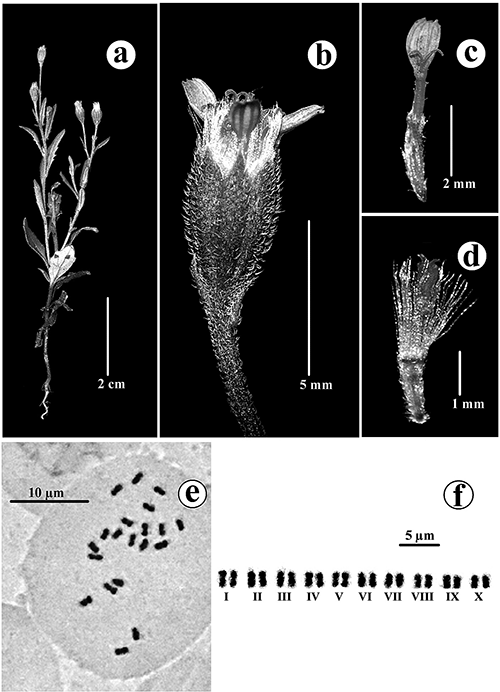2020 Volume 85 Issue 3 Pages 257-259
2020 Volume 85 Issue 3 Pages 257-259
Senecio hewrensis Hook.f. (Asteraceae) is one of endemic species to the India. Chromosome number and karyomorphology of the species were unknown. Thus, in present communication the somatic chromosome number and karyomorphology were described of S. hewrensis. Somatic chromosome number was observed 2n=20. Karyotype formula is 2n=20=20m. The karyotype is 1A of Stebbins category.
Senecio L. is one of the largest, polymorphic, and considered as a primitive genus of the family Asteraceae (Hajra et al. 1995) and distributed cosmopolitan with about 1000 species (Mabberley 2017). In India, the genus is represented by 43 species, and among them, 20 species and one variety are endemic to India (Singh et al. 2015). Although the genus represented wealth in terms of species in India, there is very few attempts has carried out to cytological work. S. hewrensis Hook.f. is less known species and grows on the dry hilly region of Maharashtra and Rajasthan states. S. hewrensis is a very unique species as it shows constant three ray floret in each capitulum (Fig. 1b).

Endemic nature, unknown cytological information and unique floral characters attracted for the karyotypic study of the species. Thus, in present communication somatic chromosome counts and basic karyomorphology have been investigated in S. hewrensis.
Cypsela of S. hewrensis was collected from the Chambar leni, Nashik city, Maharashtra state. The voucher specimen is deposited in the Herbarium, Department of Botany, Shivaji University, Kolhapur (SUK). Root tips were obtained from cypsela germinated in between two moist blotting papers in glass Petri dishes. Root tips of 4–6 mm length were pretreated with a saturated solution of p-dichlorobenzene at 6 to 11°C for 6 to 7 h (9:30–10:30 am to 3:30–4:30 pm). The root tips were squashed in 2% propionic orcein. Ten well-spread somatic chromosomes plates were analyzed for karyotype analysis following Levan et al. (1964) formulae. The well-spread somatic plates were photographed with an Olympus digital camera under an Olympus 20i microscope. The degree of karyotype asymmetry has been determined using A1 and A2 indices (Romero 1986) and the categories of Stebbins (1971).
Somatic chromosome number in S. hewrensis was observed as 2n=20 (Fig. 1e, f). Chromosomes ranged from 2.15 to 1.52 µm in length and centromeric position was observed median (m) only (Table 1). The total chromosome length of the haploid complement (TCLH) was 18.64 µm. The total form percentage (TF%) was 41.96. Symmetric Index (SI) was 72.44 and Gradient Index (GI) was 70.47. The coefficient of variation of chromosome lengths (CVcl) and Coefficient of variation of the centromeric index (CVci) were observed 11.36 and 4.07 respectively. Intrachromosomal asymmetry index (A1) and Interchromosomal asymmetry index (A2) were observed 0.67 and 0.11 respectively. The karyotype formula was observed as 2n=20=20m and 1A asymmetric category (Stebbins 1971).
| Chromosome pair | Long arm (l) (µm) | Short arm (s) (µm) | Total length c=l+s (µm) | ‘d’ value l−s (µm) | ‘r’ value l/s | ‘I’ value s/c ×100 | Centromeric position |
|---|---|---|---|---|---|---|---|
| I | 1.19±0.32 | 0.96±0.22 | 2.15±0.53 | 0.23 | 1.23 | 44.77 | m |
| II | 1.26±0.37 | 0.84±0.18 | 2.11±0.53 | 0.43 | 1.51 | 39.64 | m |
| III | 1.16±0.20 | 0.87±0.24 | 2.03±0.40 | 0.29 | 1.33 | 42.84 | m |
| IV | 1.14±0.26 | 0.83±0.22 | 1.96±0.43 | 0.31 | 1.38 | 42.04 | m |
| V | 1.11±0.28 | 0.84±0.19 | 1.95±0.42 | 0.28 | 1.33 | 42.95 | m |
| VI | 1.08±0.30 | 0.77±0.13 | 1.85±0.41 | 0.31 | 1.41 | 41.35 | m |
| VII | 0.99±0.21 | 0.75±0.19 | 1.74±0.37 | 0.24 | 1.32 | 43.10 | m |
| VIII | 0.98±0.20 | 0.69±0.15 | 1.68±0.33 | 0.29 | 1.42 | 41.34 | m |
| IX | 0.96±0.18 | 0.69±0.17 | 1.66±0.33 | 0.27 | 1.39 | 41.84 | m |
| X | 0.93±0.29 | 0.59±0.19 | 1.52±0.40 | 0.34 | 1.57 | 38.94 | m |
The genus Senecio is represented a wealth number of species and high diversification in India. However, very less cytological investigations work has been done especially on endemic species and all those species (S. candicans Wall ex DC., S. lavendulaefolius DC. and S. neelgherryanus DC.) were showed same chromosome number, 2n=20 (Shetty 1967, Mathew and Mathew 1978, 1988). Species of the Senecio which are showing basic chromosome number (x=10) considered as more primitive in the family Asteraceae because of highly symmetrical nature with median centromeres and comparatively large size of chromosomes (Mehra 1977). S. hewrensis shows advance morphological characters, only three ray florets and few disc florets (reduction of florets) and dwarf habit (reduction of size) (Fig. 1a–d), but present karyomorphological characters (x=10, median type of chromosomes, 1A asymmetric category of Stebbins classification) of S. hewrensis supports the view of Mehra (1977).
Chromosome number 2n=20 and karyomorphology of S. hewrensis is reported for the first time in the present paper. For understand the phylogenetic interrelationship of S. hewrensis karyomorphological study is needed in other endemic species of the genus Senecio.
KVCG and NAM are thankful to DST-SERB Core Research Grant project (CRG/20l8/00l381) for financial assistance. Authors are thankful to the Principals, of respective colleges for laboratory facilities.